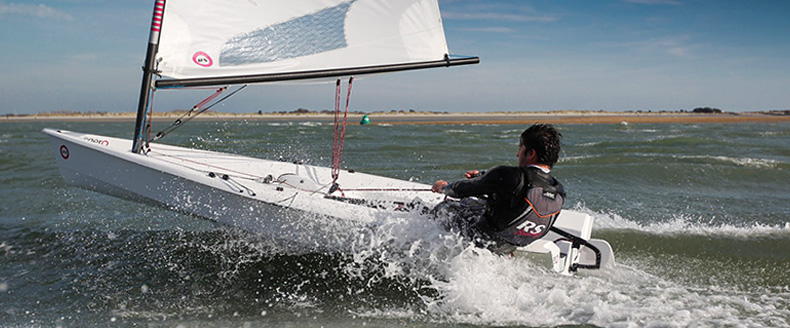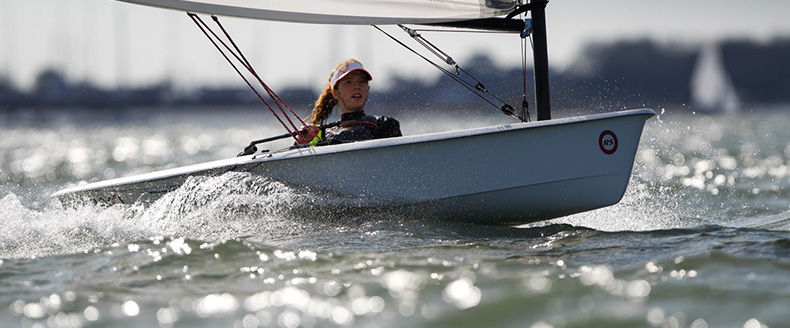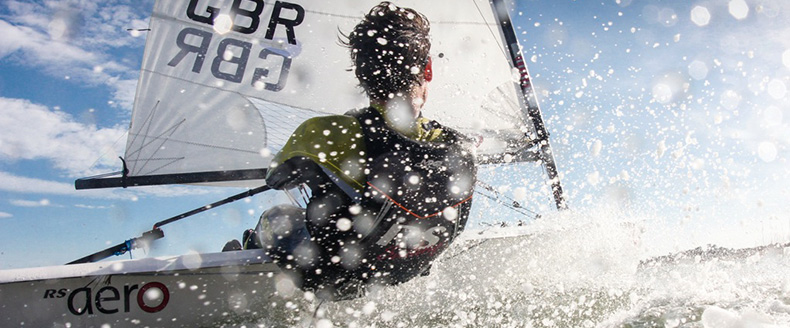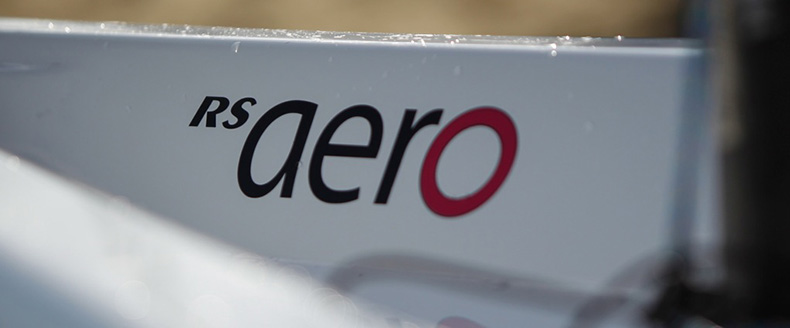
Welcome to the International Class Association website for the RS Aero. Here you will find all there is to know about the RS Aero including the latest news, how to register your boat, and links to relevant documents.




| Home >> Sailing Tips & Technique >> RS Aero 7 kicker range |
Another weekend on the water and a chance to experiment some more.
I think now I have the kicker range correct. In light airs I had the main sheet centered and hauled on as much tension as I could almost bending the boom. The kicker had very little slack to take up.
I now think the range is from boom “up†(slack kicker) to boom just off horizontal. The effort to achieve this can be done with 1 hand/arm. Thereafter further tension can be applied using the main sheet and any kicker slack then taken up when convenient.
I am happy the block built into the gooseneck for the kicker is free, but I have put a drop of lube in and when rigging for a session I make sure the kicker blocks are in no way twisted. This keeps friction to a minimum.
Class rules do allow a small block to be hung off the gooseneck in place of the built in block. I might try this in the future.
Reply
Reply
30/09/2019 22:47:00
AquaNought
Posts: 14
The Olympic Selection Trials Aeros displayed at the RYA Dinghy Show in March of this year had tapered kicker / vang 2'ry ropes.
The reduction in friction and effort needed to pull on the kicker was immediately apparent.
I was informed that this is how RS are now shipping Aeros.
I replicated on my boat, initially using 4 mm rope, and found the same reduction in effort.
I have since gone to the same rope in 5 mm used on the trials boats, obtainable from the RS Store, as I found the 4 mm started slipping in the cleat.
With the 5 mm rope I found it better to have the taper point in the section on the deck between the swivel cleat and mast foot block, as the covered 5 mm is a lot less flexible round the 18 mm blocks than the core. Whereas the trials boat had it between the gooseneck and the boom small block cascade purchase.
Don't forget it is not possible to pull on the amount of kicker required for upwind sailing without pulling on main sheet AND cunningham / downhaul first!!
Cunningham and kicker work together, and both need to be pulled on for upwind and eased in tandem when bearing off round the windward mark onto a run.
For help on tapering and other useful ropework there are a number of books available. I have found:-
Splicing Modern Ropes - A Practical Handbook, author Jan-Willem Polman,
part of the Adlard Coles Nautical Series very useful.
I think I bought mine through the RYA online web site book section.
You'll also need some tools: Rope Scissors (not ordinary ones), 4 & 5 mm Fids, and a 2 - 4 mm pulling needle - I used D-Splicer F15. All obtainable from Rooster & Pinnel & Bax.
Reply
24/09/2019 20:20:00
Jonathan Rickels
Posts: 104
24/09/2019 17:50:00
Issy
Posts: 45
Tapering the kicker line reduces the friction a LOT. I was sceptical but a fellow aeronaut insisted it made a lot of difference and she was right. Adding extra blocks would break the rules and likely not give enough range. Shortening the loop from mast base by using a cow hitch or similar on the shackle increases the range.
Reply
Reply
24/09/2019 12:05:00
Gareth
Posts: 170
Not sure if this will help much, but you could try hanging a block off the gooseneck and running the kicker control line through that down to the mast foot. You can fit a bigger block than the one hidden in the gooseneck which should reduce the loads. I also put a loop in the end of the kicker line to create a handle which helps to give a much better purchase.
I suspect this is not the case for you, but I found on my first few sailing sessions it was easy to rig the kicker line underneath the other control lines which led to friction & jams. I now rig the kicker control line last just to make sure it can run free.
I suspect I am already applying full kicker, but because the Aero rig is much “bendier†than my previous dinghies it is hard to judge !
Not sure if the above is much help to you, but you should find the application of kicker from off (boom well up) to about boom level reasonably smooth. If this is not the case try posting a picture of your setup in case someone can spot something wrong. I found the aero rigging manual about 90% right, but it left a few steps to be figured out ...
Reply
Reply
19/09/2019 22:27:00
AquaNought
Posts: 14
Hi, I have a similar issue. I found a post with recommenced max off distant from the boom to the middle sized block. However, I cannot pull anymore kicker on, other than taking up the slack, because of the amount of friction. I have checked the rigging manual and have rigged it correctly so don’t understand what the problem is. Being a lightweight I tend to need to de-power earlier than most so don’t know how to fix this. Any help on rigging the kicker to reduce that friction would be appreciated. Isabelle
Reply
Reply
19/09/2019 18:38:00
Issy
Posts: 45
Hi,
I'm enjoying getting to grips with my new Aero, but as there are no other Aero's nearby I am working out most of the settings for kicker/downhaul/outhaul by trial and error with some help from posts in this forum (thanks to all those who've taken the time to write helpful guidance).
I'm happy that I have my kicker set correctly for the "full off" position, thanks again to various posts on this forum.
My problem is knowing what the sensible "full on" position is. I find that with little effort one hand can get the boom more or less level and when I get fully close hauled there is just a little bit more slack to take up. At this point the kicker load goes from fairly light to locked - although there is plenty of travel left available. However if I apply 2 hands I can get quite a bit more kicker on, but perhaps this is over-stressing the rig ?
In high winds I'm not sure if I am getting enough kicker (or maybe too much) and was wondering if someone knows or has access to a measurement that I can use to set a max position. I was thinking something like height of boom off deck or centreline.
Currently without the sail the kicker maxes out with the boom pointing downwards by probably 15 - 20 degrees.
Any guidance much appreciated, once I have a min-max range I can go back to playing around with settings with a bit more confidence on what the limits are.
Reply
19/09/2019 11:49:00
AquaNought
Posts: 14











